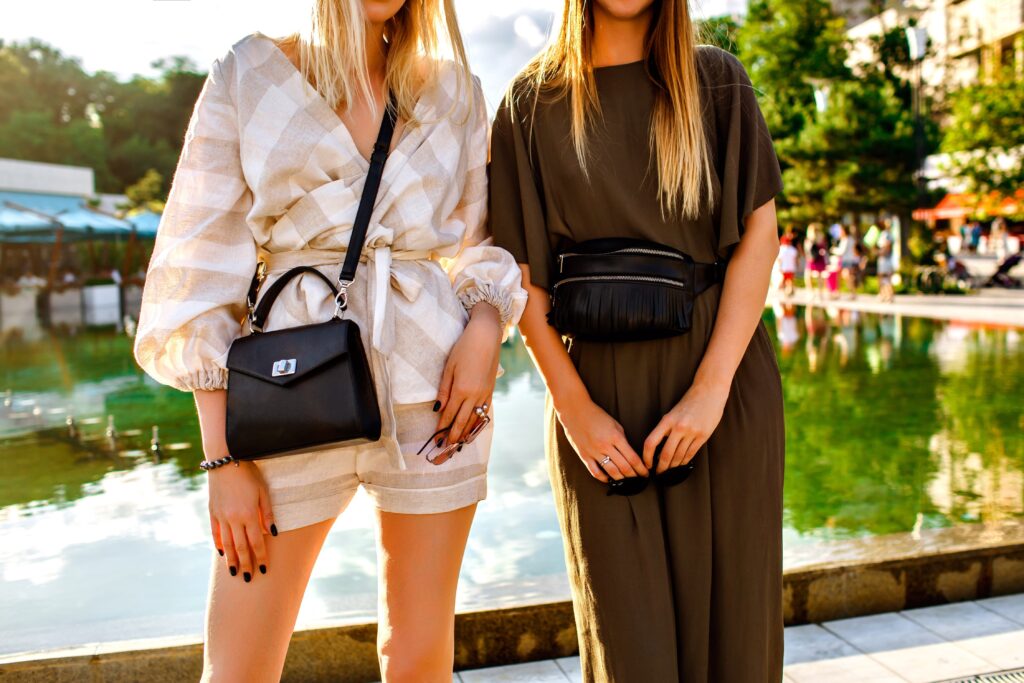Handbags and purses are an essential part of daily life for many people, providing a practical and fashionable way to carry essentials such as phones, wallets, and keys. Over the years, the styles and designs of handbags have evolved dramatically, reflecting changes in fashion, culture, and technology. In recent years, there has also been a growing focus on sustainable materials and eco-friendly practices in handbag design. This article will explore the history of fashionable purse styles and the rise of sustainable materials in handbag design.
Historical evolution of purse styles
Handbags and purses have been used for thousands of years, dating back to ancient times. In ancient Egypt, both men and women carried small pouches around their waists to carry their everyday essentials. These pouches were often made of linen, leather, or precious metals. During the Middle Ages in Europe, purses were used mainly by men and were attached to their belts. They were often made of leather and were used to carry coins and other small items.
In the 16th century, women began carrying small bags called reticules, which were often decorated with embroidery, lace, or beads. These bags were used to carry personal items such as handkerchiefs, combs, and smelling salts. During the 19th century, as fashion became more ornate, purses also became more elaborate. Women carried small bags made of silk or velvet, often adorned with jewels or beading.
During the 20th century, the styles of handbags continued to evolve, reflecting the changing trends and fashions of the times. In the 1920s, the “flapper” style became popular, and women began carrying small, beaded purses with long straps. These bags were meant to be worn cross-body, allowing women to dance and move freely without worrying about their purses.
During World War II, leather and other materials were in short supply, leading to the creation of handbags made from unconventional materials such as wood, straw, and even metal. These bags were often simple in design and had a utilitarian feel.
In the 1950s, the emergence of high-end fashion houses such as Chanel and Dior led to the creation of more luxurious handbags. These bags were often made of leather and were designed to match or complement the clothing worn by the owner.
In the 1960s, the “mod” style became popular, and handbags were often bright and bold, featuring geometric shapes and graphic prints. In the 1980s, the popularity of designer labels such as Gucci and Prada led to the emergence of the “It” bag, a highly coveted and often expensive handbag that became a symbol of status.
Factors influencing fashionable purse styles
Various factors, including societal norms, technological advancements, and the emergence of new materials, have influenced the evolution of fashionable purse styles. In the 1990s, the popularity of grunge and alternative fashion led to the emergence of the “slouchy” bag, a soft and unstructured style that contrasted with the structured and polished bags of the previous decade.
The events of 9/11 in 2001 had a significant impact on handbag styles, with many designers creating stylish and functional bags featuring security features such as RFID-blocking technology and hidden pockets.
Globalization and the rise of travel have also influenced fashionable purse styles. With more people traveling and needing to carry essentials with them, designers have created travel-friendly bags such as cross-body styles and convertible backpacks.
In recent years, social media has significantly impacted handbag trends, with influencers and celebrities often driving demand for specific styles and brands.
Practical and functional purse styles
When it comes to practical and functional purse styles, a few popular types come to mind. Cross-body bags are versatile and convenient, leaving your hands free to carry other things or move around more easily. Tote bags are spacious and great for carrying a lot of items, such as a laptop, books, or groceries. Backpacks are a comfortable and durable option, especially if you have a lot to carry or are traveling.
Clutch bags are a simple and elegant option, great for evening events or occasions when you only need to carry a few essentials. And satchel bags are structured and stylish, often featuring a top handle and a shoulder strap.
Sustainable materials in handbag design
As the fashion industry becomes more aware of its environmental impact, many designers are incorporating sustainable materials and eco-friendly practices into their designs. Vegan leather is synthetic leather made from materials such as polyurethane or polyvinyl chloride rather than animal hides. It can be made to look and feel like real leather but is often more affordable and easier to care for. Some vegan leathers are also more sustainable than traditional leather, as they may use fewer resources and produce less waste during production.
Sustainable fabrics such as organic cotton, hemp, and recycled polyester are also increasingly being used in handbag design. These materials are typically grown or produced in a way that is more environmentally friendly than traditional fabrics, and they may also be more durable and long-lasting.
In addition to using sustainable materials, many designers also incorporate eco-friendly practices into their production processes, such as using recycled materials for packaging or reducing waste during manufacturing.
Fashionable handbag designers using sustainable materials
Several fashionable handbag designers use sustainable materials and eco-friendly production practices. Stella McCartney is a luxury fashion brand at the forefront of sustainable fashion for many years. The brand uses various sustainable materials in its handbags, including vegan leather made from recycled polyester and organic cotton.
Matt & Nat is a Canadian handbag brand that uses vegan leather made from recycled materials such as plastic bottles, nylon, and rubber. The brand is committed to using sustainable materials and eco-friendly production processes.
Rothy’s is a sustainable fashion brand known for its shoes but also offers a range of stylish handbags made from recycled plastic bottles. The brand uses a 3D knitting process to create its bags, which reduces waste and uses fewer resources than traditional manufacturing methods.
Elvis & Kresse is a UK-based brand that creates handbags and accessories from reclaimed materials, such as decommissioned fire hoses and military parachute silk. The brand is committed to using sustainable materials and has won several awards for its eco-friendly practices.
Final Thoughts
Handbags and purses have come a long way over the years, from simple pouches and waist bags to luxurious designer handbags and eco-friendly options made from sustainable materials. As we continue to focus on sustainability and reducing the environmental impact of the fashion industry, it’s exciting to see more designers incorporating sustainable materials and eco-friendly production practices into their designs. Whether you prefer a cross-body bag, a tote bag, or a backpack, there are plenty of stylish and sustainable options to choose from.









Reader Interactions